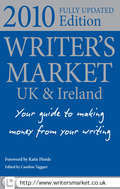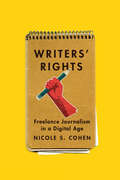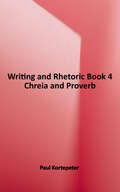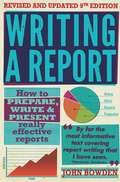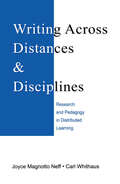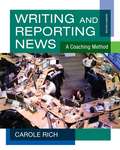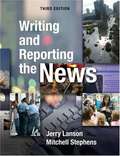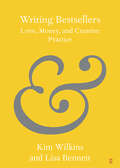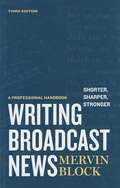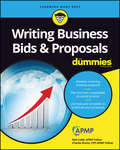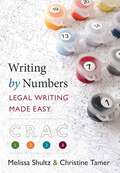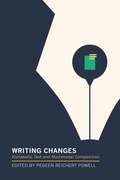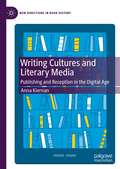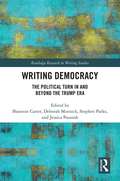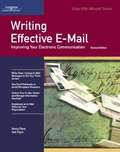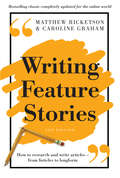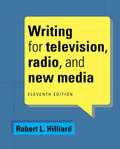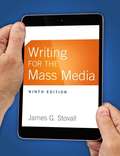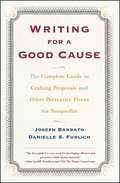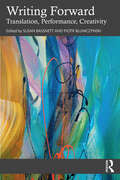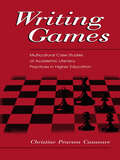- Table View
- List View
Writer's Market 2010: Make Money Writing
by Caroline TaggartTHE MOST TRUSTED GUIDE TO GETTING PUBLISHED Written by writers for writers and backed by 89 years of authority, Writer's Market is the #1 resource for helping writers sell their work. Used by both seasoned professionals and writers new to the publishing world, Writer's Market has helped countless writers transform their love of writing from a hobby into a career. Nowhere else but in the 2010 Writer's Market will you find the most comprehensive and reliable information you need. This new edition includes: Complete, up-to-date contact information and submission guidelines for more than 3,500 market listings, including literary agents, book publishers, magazines, newspapers, production companies, theaters, greeting card companies, and more. Informative interviews, helpful tips and instructional articles on the business of writing. The "How Much Should I Charge?" pay rate charts for professional freelancers. Sample good and bad queries in the "Query Letter Clinic." Easy-to-use format and tabbed pages so you can quickly locate the information you need!
Writers' Rights: Freelance Journalism in a Digital Age
by Nicole S. CohenAs media industries undergo rapid change, the conditions of media work are shifting just as quickly, with an explosion in the number of journalists working as freelancers. Although commentary frequently lauds freelancers as ideal workers for the information age - adaptable, multi-skilled, and entrepreneurial - Nicole Cohen argues that freelance media work is increasingly precarious, marked by declining incomes, loss of control over one's work, intense workloads, long hours, and limited access to labour and social protections. Writers' Rights provides context for freelancers' struggles and identifies the points of contention between journalists and big business. Through interviews and a survey of freelancers, Cohen highlights the paradoxes of freelancing, which can be simultaneously precarious and satisfying, risky and rewarding. She documents the transformation of freelancing from a way for journalists to resist salaried labour in pursuit of autonomy into a strategy for media firms to intensify exploitation of freelance writers' labour power, and presents case studies of freelancers' efforts to collectively transform their conditions. A groundbreaking and timely intervention into debates about the future of journalism, organizing precariously employed workers, and the transformation of media work in a digital age, Writers' Rights makes clear what is at stake for journalism's democratic role when the costs and risks of its production are offloaded onto individuals.
Writers' Rights: Freelance Journalism in a Digital Age
by Nicole S. CohenAs media industries undergo rapid change, the conditions of media work are shifting just as quickly, with an explosion in the number of journalists working as freelancers. Although commentary frequently lauds freelancers as ideal workers for the information age – adaptable, multi-skilled, and entrepreneurial – Nicole Cohen argues that freelance media work is increasingly precarious, marked by declining incomes, loss of control over one’s work, intense workloads, long hours, and limited access to labour and social protections. Writers’ Rights provides context for freelancers’ struggles and identifies the points of contention between journalists and big business. Through interviews and a survey of freelancers, Cohen highlights the paradoxes of freelancing, which can be simultaneously precarious and satisfying, risky and rewarding. She documents the transformation of freelancing from a way for journalists to resist salaried labour in pursuit of autonomy into a strategy for media firms to intensify exploitation of freelance writers’ labour power, and presents case studies of freelancers’ efforts to collectively transform their conditions. A groundbreaking and timely intervention into debates about the future of journalism, organizing precariously employed workers, and the transformation of media work in a digital age, Writers’ Rights makes clear what is at stake for journalism’s democratic role when the costs and risks of its production are offloaded onto individuals.
Writing & Rhetoric Book 4: Chreia & Proverb
by Paul KortepeterThe Writing and Rhetoric series method employs fluent reading, careful listening, models for imitation, and progressive steps. It assumes that students learn best by reading excellent, whole-story examples of literature and by growing their skills through imitation. Each exercise is intended to impart a skill (or tool) that can be employed in all kinds of writing and speaking. The exercises are arranged from simple to more complex. What's more, the exercises are cumulative, meaning that later exercises incorporate the skills acquired in preceding exercises. This series is a step-by-step apprenticeship in the art of writing and rhetoric.
Writing A Report, 9th Edition: How To Prepare, Write And Present Really Effective Reports
by John BowdenNow in its 9th edition, this extensively revised and updated handbook explains how you can write reports that will be: * Read without unnecessary delay * Understood without undue effort Accepted, and where applicable, acted upon / Divided into three parts, the book looks in detail firstly at the practical side of report writing: * Preparation and planning * Collecting and handling information * Writing and revising / Secondly, at the creative side of report writing: * Achieving a good style and choosing the correct words * Improving the overall appearance of reports / And thirdly at 23 common types of report, including: * Annual reports/ Appraisal reports * Audit reports Minutes/Progress reports * Student project reports/Technical reports / There is also an extensive glossary and a selection of sample reports.
Writing A Report, 9th Edition: How to prepare, write & present really effective reports
by John BowdenNow in its 9th edition, this extensively revised and updated handbook explains how you can write reports that will be: * Read without unnecessary delay * Understood without undue effort Accepted, and where applicable, acted upon / Divided into three parts, the book looks in detail firstly at the practical side of report writing: * Preparation and planning * Collecting and handling information * Writing and revising / Secondly, at the creative side of report writing: * Achieving a good style and choosing the correct words * Improving the overall appearance of reports / And thirdly at 23 common types of report, including: * Annual reports/ Appraisal reports * Audit reports Minutes/Progress reports * Student project reports/Technical reports / There is also an extensive glossary and a selection of sample reports.
Writing Across Distances and Disciplines: Research and Pedagogy in Distributed Learning
by Joyce Magnotto Neff Carl WhithausWriting Across Distances and Disciplines addresses questions that cross borders between onsite, hybrid, and distributed learning environments, between higher education and the workplace, and between distance education and composition pedagogy. This groundbreaking volume raises critical issues, clarifies key terms, reviews history and theory, analyzes current research, reconsiders pedagogy, explores specific applications of WAC and WID in distributed environments, and considers what business and education might teach one another about writing and learning. Exploring the intersection of writing across the curriculum, composition studies, and distance learning , it provides an in-depth look at issues of importance to students, faculty, and administrators regarding the technological future of writing and learning in higher education.
Writing And Reporting News: A Coaching Method
by Carole RichPrepare yourself for the changing world of journalism with WRITING AND REPORTING NEWS: A COACHING METHOD, the book that integrates new trends in the convergence of print, broadcast and online media while teaching fundamental skills. With new information about social media, mobile media, blogs, and new skills you'll need for whatever career you choose, the seventh edition features tips, techniques, and real-life stories from writing coaches and award-winning journalists. A strong storytelling approach makes the text accessible and interesting, helping you easily master the writing and reporting techniques you'll need for media careers now and in the future.
Writing And Reporting The News
by Mitchell Stephens Jerry LansonWriting and Reporting the News, Third Edition, is a comprehensive and accessible introductory text for journalism students. Jerry Lanson and Mitchell Stephens provide thorough instruction on writing and reporting, hundreds of examples of good and bad writing and extensive opportunities to apply their advice through practical exercises. Based on the authors' careers as journalists and journalism professors--and on the experience of dozens of other first-rate reporters--this unique textbook/workbook gives students a clear, logical introduction to the craft of journalism. <p><p> Discussions and examples have been updated throughout for this new edition. A new section covers writing for the Internet, the authors have added boxed sections in which reporters offer tips on how to cover specific types of stories and beats, and the Instructor's Manual to accompany the book is now available on the companion website.
Writing Bestsellers: Love, Money and Creative Practice (Elements in Publishing and Book Culture)
by Kim Wilkins Lisa BennettWhile the term 'bestseller' explicitly relates books to sales, commercially successful books are also products of individual creative work. This Element presents a new perspective on the relationship between art and the market, with particular reference to bestselling writers and books. We examine some existing perspectives on art's relationship to the marketplace to trouble persistent binaries that see the two in opposition; we break down the monolith of the marketplace by thinking of it as made up of a range of invested, non-hostile participants such as publishing personnel and readers; we articulate the material dimensions of creative writing in the industry through the words of bestselling writers themselves; and we examine how the existence of bestselling books and writers in the world of letters bears enormous influence on the industry, and on the practice of other writers.
Writing Broadcast News: Shorter, Sharper, Stronger
by Mervin BlockMervin Block- who has written for the best in the business- offers timeless advice, guiding both first-year students and seasoned professionals through the essentials of writing for the ear. With countless scripts collected from writing workshops in newsrooms across the country, this resource is studded with insightful- and at times entertaining- comments, suggestions and much-needed corrections. Readers will find Block's clear and incisive voice coming through in the expanded "Top Tips of the Trade" and the "Dozen Deadly Sins"—reminding us that mistakes can be our best teachers. New "WordWatcher" boxes highlight the challenges in writing for print versus broadcast.
Writing Business Bids and Proposals For Dummies
by Neil Cobb Charlie DivineDevelop a winning business proposal Plan and use a repeatable proposal process Use tools and templates to accelerate your proposals Get the intel on bids and proposals Congratulations! You have in your hands the collected knowledge and skills of the professional proposal writer – without having to be one! Inside, you'll find out how to unlock what these professionals know and apply it to your own business to improve the way you capture new customers and communicate with existing ones! Inside... Develop a great proposal Focus on the customer Know your competition Plan your approach Use tools and templates Write persuasively Overcome misconceptions Expand your skills Avoid proposal killers
Writing By Numbers: Legal Writing Made Easy
by Melissa Shultz Christine TamerGiven the reality that legal writing is difficult for most new law students, Writing by Numbers: Legal Writing Made Easy aims to demystify the writing process by providing concrete formulas for mastering objective and persuasive legal writing. Put simply, at each juncture of your journey to become a proficient legal writer, this book gives you a roadmap to follow, broadly starting with the macro-formula CRAC (Conclusion, Rule, Analysis, and Conclusion) and then moving to micro-formulas for each part of the macro formula. The goal is that you will never find yourself lost―that is, you will never find yourself facing an entirely blank page without direction.
Writing Centers at the Center of Change (Routledge Research in Writing Studies)
by Joe Essid Brian McTagueWriting Centers at the Center of Change looks at how eleven centers, internationally, adapted to change at their institutions, during a decade when their very success has become a valued commodity in a larger struggle for resources on many campuses. Bringing together both US and international perspectives, this volume offers solutions for adapting to change in the world of writing centers, ranging from the logistical to the pedagogical, and even to the existential. Each author discusses the origins, appropriate responses, and partners to seek when change comes from within a school or outside it. Chapters document new programs being formed under changing circumstances, and suggest ways to navigate professional or pedagogical changes that may undermine the hard work of more than four decades of writing-center professionals. The book’s audience includes writing center and learning-commons administrators, university librarians, deans, department chairs affiliated with writing centers. It will also be useful for graduate students in composition, rhetoric, and academic writing.
Writing Changes: Alphabetic Text And Multimodal Composition
by Pegeen Reichert PowellWriting Changes moves beyond restrictive thinking about composition to examine writing as a material and social practice rich with contradictions. It analyzes the assumed dichotomy between writing and multimodal composition (which incorporates sounds, images, and gestures) as well as the truism that all texts are multimodal. Organized in four sections, the essays explore• alphabetic text and multimodal composition in writing studies• specific pedagogies that place writing in productive conversation with multimodal forms• current representations of writing and multimodality in textbooks, of instructors' attitudes toward social media, and of writing programs• ideas about writing studies as a discipline in the light of new communication practicesBookending the essays are an introduction that frames the collection and establishes key terms and concepts and an epilogue that both sums up and complicates the ideas in the essays.
Writing Cultures and Literary Media: Publishing and Reception in the Digital Age (New Directions in Book History)
by Anna KiernanThis Pivot investigates the impact of the digital on literary culture through the analysis of selected marketing narratives, social media stories, and reading communities. Drawing on the work of contemporary writers, from Bernardine Evaristo to Patricia Lockwood, each chapter addresses a specific tension arising from the overarching question: How has writing culture changed in this digital age? By examining shifting modes of literary production, this book considers how discourses of writing and publishing and hierarchies of cultural capital circulate in a socially motivated post-digital environment. Writing Cultures and Literary Media combines compelling accounts of book trends, reader reception, and interviews with writers and publishers to reveal fresh insights for students, practitioners, and scholars of writing, publishing, and communications.
Writing Democracy: The Political Turn in and Beyond the Trump Era (Routledge Research in Writing Studies)
by Steve Parks Shannon Carter Deborah Mutnick Jessica PauszekWriting Democracy: The Political Turn in and Beyond the Trump Era calls on the field of writing studies to take up a necessary agenda of social and economic change in its classrooms, its scholarship, and its communities to challenge the rise of neoliberalism and right-wing nationalism. Grown out of an extended national dialogue among public intellectuals, academic scholars, and writing teachers, collectively known as the Writing Democracy project, the book creates a strategic roadmap for how to reclaim the progressive and political possibilities of our field in response to the "twilight of neoliberalism" (Cox and Nilsen), ascendant right-wing nationalism at home (Trump) and abroad (Le Pen, Golden Dawn, UKIP), and hopeful radical uprisings (Black Lives Matter, Occupy Wall Street, Arab Spring). As such, the book tracks the emergence of a renewed left wing in rhetoric and activism post-2008, suggests how our work as teachers, scholars, and administrators can bring this new progressive framework into our institutions, and then moves outward to our role in activist campaigns that are reshaping public debate. Part history, part theory, this book will be an essential read for faculty, graduate students, and advanced undergraduate students in composition and rhetoric and related fields focused on progressive pedagogy, university-community partnerships, and politics.
Writing Effective E-Mail: Improving Your Electronic Communication
by Nancy Flynn Tom FlynnThe revised edition of Writing Effective E-Mail includes an added emphasis on how to avoid workplace disasters such as lost sales, customer service nightmares--and in the worst cases--lawsuits and financial losses, triggered by careless or poorly written e-mails. This book will also guide you in writing a comprehensive and effective e-mail policy for your organization.
Writing Feature Articles
by Brendan HennessyHennessy's classic text tells you everything you need to know about writing successful features. You will learn how to formulate and develop ideas and how to shape them to fit different markets. Now in its fourth edition, Writing Feature Articles has been fully revised and updated to take into account the changing requirements of journalism and media courses. You will also discover how to exploit new technology for both researching and writing online.Learn step-by-step how to plan, research and write articles for a wide variety of 'popular', 'quality' and specialist publications. Discover more and make the advice stick by completing the tasks and reading the keen analysis of extracts from the best of today's writing.Packed with inspirational advice in a friendly, highly readable style, this guide is a must-have for practising and aspiring journalists and writers.
Writing Feature Stories: How to research and write articles - from listicles to longform
by Caroline Graham Matthew RicketsonGood writing engages as it informs and feature journalism offers writers the opportunity to tell deep, affecting stories that look beyond the immediate mechanics of who, what, where and when and explore the more difficult-and more rewarding- questions: how and why? Whether you're a blogger, a news journalist or an aspiring lifestyle reporter, a strong voice and a fresh, informed perspective remain in short supply and strong demand; this book will help you craft the kind of narratives people can't wait to share on their social media feeds.Writing Feature Stories established a reputation as a comprehensive, thought-provoking and engaging introduction to researching and writing feature stories. This second edition is completely overhauled to reflect the range of print and digital feature formats, and the variety of online, mobile and traditional media in which they appear.This hands-on guide explains how to generate fresh ideas; research online and offline; make the most of interviews; sift and sort raw material; structure and write the story; edit and proofread your work; find the best platform for your story; and pitch your work to editors.'A wide-ranging, much-needed master class for anyone who tells true yarns in this fast-changing journalistic marketplace' - Bruce Shapiro, Columbia University'Useful and thought provoking' - Margaret Simons, journalist and author'A must read for any digital storyteller who wants to write emotive, engaging, believable content.' - Nidhi Dutt, foreign correspondent
Writing For Television, Radio, And New Media
by Robert L. HilliardYou can trust Hilliard's WRITING FOR TELEVISION, RADIO, AND NEW MEDIA to provide you with thorough and up-to-date coverage of the principles, techniques, and approaches of writing for television, radio, and the Internet. You'll learn about writing for a variety of formats, such as commercials, news and sports, documentaries, reality programs, talk shows, interviews, music programs, and drama and sitcoms. The book's comprehensive content, excellent organization, attention to form, and good examples ensure that you will be well trained for a career in the field.
Writing For The Mass Media (Ninth Edition)
by James G. StovallA clear and effective introduction to media writing Writing for the Mass Media offers clear writing, simple organization, abundant exercises, and precise examples that give students information about media writing and opportunities to develop their skills as professional writers. With a focus on a converged style of media writing, and converting that style into real work, this ninth edition maintains its classic and effective text/workbook format while staying ahead of the curve and preparing students for their future careers. MyCommunicationLab is an integral part of the Stovall program. MediaShare allows students to post speeches and share them with classmates and instructors. Interactive videos provide students with the opportunity to watch and evaluate sample speeches. Online self-assessments and pre- and post-tests help students assess their comfort level with public speaking and their knowledge of the material.
Writing For a Good Cause
by Joseph Barbato Danielle FurlichFilled with tips and survival skills from writers and fund-raising officers at nonprofits of all sizes, Writing for a Good Cause is the first book to explain how to use words well to win your cause the money it needs. Whether you work for a storefront social action agency or a leading university, the authors' knowledgeable, practical advice will help you: Write the perfect proposal -- from the initial research and interviews to the final product Draft, revise, and polish a "beguiling, exciting, can't-put-it-down and surely can't-turn-it-down" request for funds Create case statements and other big money materials -- also write, design, and print newsletters, and use the World Wide Web effectively Survive last-minute proposals and other crises -- with the Down-and-Dirty Proposal Kit! Writing for a Good Cause provides everything fund raisers, volunteers, staff writers, freelancers, and program directors need to know to win funds from individual, foundation, and corporate donors.
Writing Forward: Translation, Performance, Creativity
by Susan BassnettThis collection of essays by a team of internationally respected researchers at the cutting edge of translation studies was inspired by the idea of “writing forward” as a strategy for theatre translation proposed by David Johnston, the award-winning translator and scholar.Opening this volume is a conversation between David Johnston and Lawrence Venuti in which they explore a broad range of topics that bear on the translation of theatrical texts for performance. The chapters that follow are grouped into three main parts. Part I, “Extending translation”, contains essays whose respective theoretical emphases test, push, and stretch traditional conceptual boundaries. Part II, “Translating for theatre”, zooms in on various aspects of theatre translation. Part III, “Translation and creativity”, shifts the focus beyond the stage to other forms of artistic expression: poetry, painting, film, and television. Finally, in the short play Noli me tangere, written especially for this volume, Juan Mayorga reflects on theatre as the art of distance and on the mysteriousness of translation as the art of negotiating that distance.Thinking about and practicing translation as “writing forward” underscores its perpetual provisionality and hermeneutic openness; its ability to surprise and stimulate but also remind and reassure. By enriching our understanding of translation, performance, and creativity, this volume will no doubt inspire further explorations into their fascinating complexities. Useful and important reading for advanced students and researchers of literature, theatre, culture, and translation.
Writing Games: Multicultural Case Studies of Academic Literacy Practices in Higher Education
by Christine Pears CasanaveThis book explores how writers from several different cultures learn to write in their academic settings, and how their writing practices interact with and contribute to their evolving identities as students and professionals in academic environments in higher education. Embedded in a theoretical framework of situated practice, the naturalistic case studies and literacy autobiographies include portrayals of undergraduate students and teachers, master's level students, doctoral students, young bilingual faculty, and established scholars, all of whom are struggling to understand their roles in ambiguously defined communities of academic writers. In addition to the notion of situated practice, the other powerful concept used as an interpretive framework is captured by the metaphor of "games"--a metaphor designed to emphasize that the practice of academic writing is shaped but not dictated by rules and conventions; that writing games consist of the practice of playing, not the rules themselves; and that writers have choices about whether and how to play. Focusing on people rather than experiments, numbers, and abstractions, this interdisciplinary work draws on concepts and methods from narrative inquiry, qualitative anthropology and sociology, and case studies of academic literacy in the field of composition and rhetoric. The style of the book is accessible and reader friendly, eschewing highly technical insider language without dismissing complex issues. It has a multicultural focus in the sense that the people portrayed are from a number of different cultures within and outside North America. It is also a multivocal work: the author positions herself as both an insider and outsider and takes on the different voices of each; other voices that appear are those of her case study participants, and published authors and their case study participants. It is the author's hope that readers will find multiple ways to connect their own experiences with those of the writers the book portrays.
